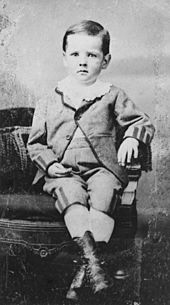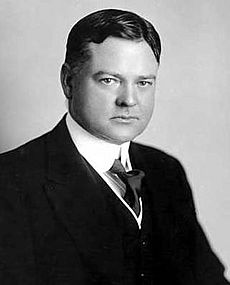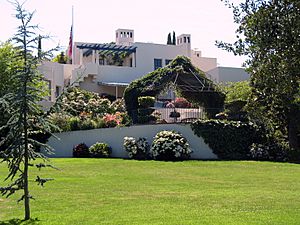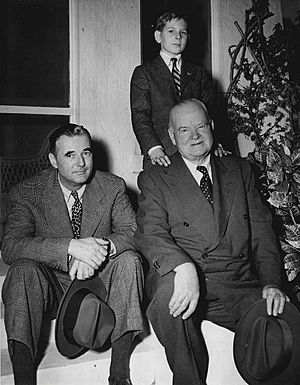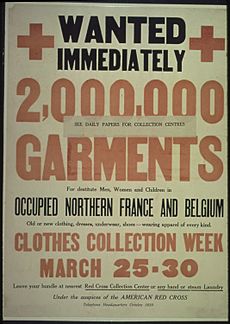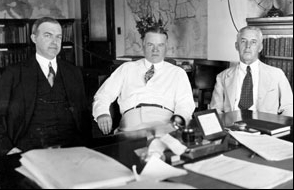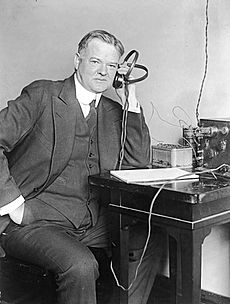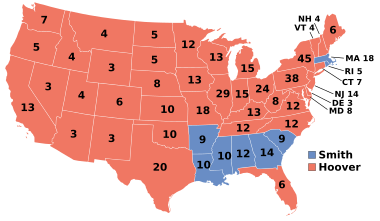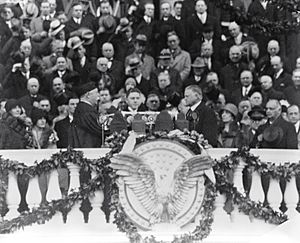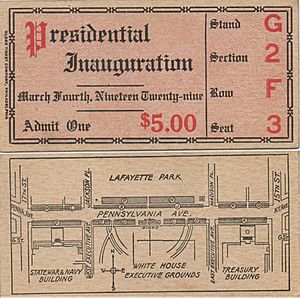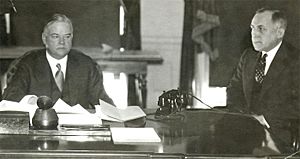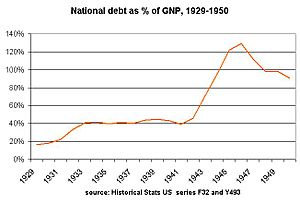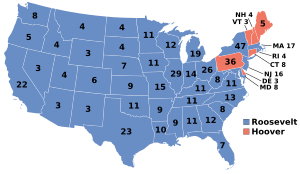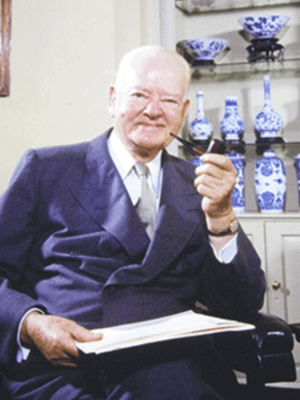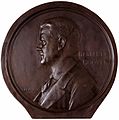Herbert Hoover facts for kids
Quick facts for kids
Herbert Hoover
|
|
|---|---|
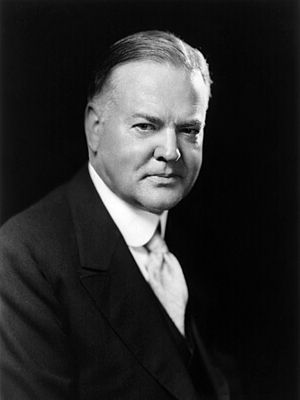
Hoover in 1928
|
|
| 31st President of the United States | |
| In office March 4, 1929 – March 4, 1933 |
|
| Vice President | Charles Curtis |
| Preceded by | Calvin Coolidge |
| Succeeded by | Franklin D. Roosevelt |
| 3rd United States Secretary of Commerce | |
| In office March 5, 1921 – August 21, 1928 |
|
| President |
|
| Preceded by | Joshua W. Alexander |
| Succeeded by | William F. Whiting |
| Director of the United States Food Administration | |
| In office August 21, 1917 – November 16, 1918 |
|
| President | Woodrow Wilson |
| Preceded by | Position established |
| Succeeded by | Position abolished |
| Chair of the Commission for Relief in Belgium | |
| In office October 22, 1914 – April 14, 1917 |
|
| Preceded by | Position established |
| Succeeded by | Position abolished |
| Personal details | |
| Born |
Herbert Clark Hoover
August 10, 1874 West Branch, Iowa, U.S. |
| Died | October 20, 1964 (aged 90) New York City, U.S. |
| Resting place | Herbert Hoover Presidential Library and Museum |
| Political party | Republican |
| Spouse | |
| Children |
|
| Education | Stanford University (BS) |
| Occupation |
|
| Signature | |
Herbert Clark Hoover (August 10, 1874 – October 20, 1964) was the 31st president of the United States. He served from 1929 to 1933. He was a member of the Republican Party. His time as president began just as the Great Depression started.
Before becoming president, Hoover was a self-made man. He became rich as a mining engineer. He also led important groups like the Commission for Relief in Belgium. This group helped feed people during World War I. He was also the director of the U.S. Food Administration and the U.S. Secretary of Commerce.
Hoover was born into a Quaker family in West Branch, Iowa. He grew up in Oregon. He was one of the first students to graduate from the new Stanford University in 1895. His work as a mining engineer took him to Australia and China. After World War I, he led the American Relief Administration. This group provided food to millions of starving people in Europe.
In 1920, President Warren G. Harding made Hoover the Secretary of Commerce. He kept this job under President Calvin Coolidge. Hoover was a very active Cabinet member. He helped develop air travel and radio. He also led the government's response to the Great Mississippi Flood of 1927. In 1928, Hoover won the presidential election by a lot. But soon after he became president, the stock market crashed. This started the Great Depression.
The Great Depression was the main challenge of Hoover's presidency. He tried different economic plans to fix the economy. However, he was defeated by Franklin D. Roosevelt in the 1932 election. Hoover lived for over 31 years after leaving office. He wrote many books and became more conservative. He criticized Roosevelt's policies. Later, his public image improved because he helped presidents Harry S. Truman and Dwight D. Eisenhower.
Contents
Early Life and Education
Herbert Clark Hoover was born on August 10, 1874, in West Branch, Iowa. His father, Jesse Hoover, was a blacksmith. His mother, Hulda Randall Minthorn, was a Quaker. When he was two, he got very sick but was saved by his uncle. His father died in 1880 when Herbert was six. His mother died in 1884 when he was ten. This left Herbert and his two siblings as orphans. He then lived with his uncle Allen Hoover on a farm.
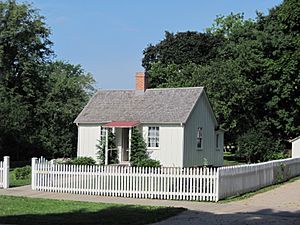
In 1885, Hoover moved to Newberg, Oregon. He lived with his uncle John Minthorn, a doctor and businessman. Hoover attended Friends Pacific Academy but left at age thirteen. He became an office assistant for his uncle's real estate business. He learned important skills like bookkeeping and typing at night school.
Hoover was part of the first class at Stanford University in 1891. He got in even though he failed most of his entrance exams, except for math. He studied geology. To save money, he helped start the first student housing cooperative at Stanford. Hoover was an average student. He spent a lot of time working part-time jobs and doing campus activities. He was student manager for both the baseball and football teams. He also helped organize the first "Big Game" against the University of California.
Becoming a Mining Engineer
Working for Bewick, Moreing
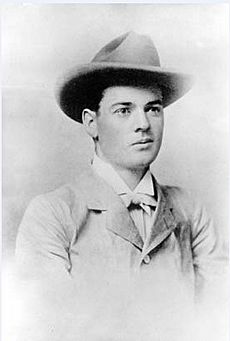
After graduating from Stanford in 1895, Hoover found it hard to get a job. The country was in an economic downturn. He worked in small mining jobs until he was hired by Louis Janin, a famous mining engineer. Later, he joined Bewick, Moreing & Co., a company in London that ran gold mines in Western Australia.
Hoover traveled a lot to check on and manage the company's mines. He helped Bewick buy the Sons of Gwalia gold mine, which became very successful. He brought in many Italian immigrants to work in the mines. This helped cut costs. Hoover became a junior partner in the company in 1898.
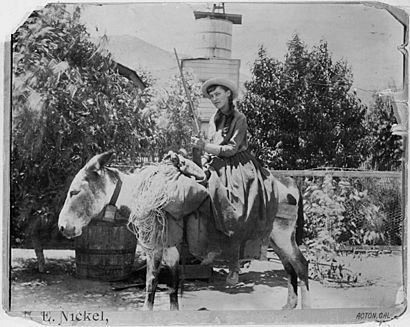
Hoover then went to China to develop gold mines. He became interested in Chinese history. The Boxer Rebellion started soon after he arrived. He and other foreigners were trapped until a multi-national army helped them. Hoover became a key partner in a new Chinese mining company in 1901. He traveled the world for Bewick, visiting mines on different continents. He left the company in 1908.
Independent Work
After leaving Bewick, Moreing, Hoover became an independent mining consultant. He focused on finding money for new mining projects and fixing troubled ones. He was known as a "doctor of sick mines." He invested in mines all over the world. By 1914, Hoover was a very rich man. His personal fortune was about $4 million.
He also co-founded the Zinc Corporation in Australia. This company developed new ways to get zinc from ore. Hoover also worked with the Burma Corporation, which produced silver, lead, and zinc. He helped increase copper production in Russia.
In his free time, Hoover wrote books. His lectures were published in 1909 as Principles of Mining. This book became a standard textbook. He also became interested in the history of science. In 1912, Hoover and his wife published the first English translation of De re metallica, an important old book about mining.
Marriage and Family Life
During his last year at Stanford, Hoover fell in love with a classmate named Lou Henry. She was studying geology. In 1898, after getting a promotion, Hoover asked Lou Henry to marry him. She said yes, and they got married. They stayed married until Lou Henry Hoover died in 1944.
Hoover and his wife had two children: Herbert Hoover Jr. (born in 1903) and Allan Henry Hoover (born in 1907). The Hoover family lived in London starting in 1902. They traveled often because of Hoover's work. After 1916, they lived in the United States, with homes in Stanford, California, and Washington, D.C..
World War I and Humanitarian Work
Helping Europe During the War
When World War I started in August 1914, many Americans were stuck in Europe. Hoover helped create a committee to bring them home. He became the committee's leader. He later said that this was the start of his public life. By October 1914, his group had helped over 40,000 Americans.
The German invasion of Belgium in 1914 caused a food crisis. Belgium relied on imported food. The Germans would not feed the Belgians. The British would not let food into German-occupied Belgium unless the U.S. supervised it. Hoover then set up the Commission for Relief in Belgium (CRB). The CRB brought in millions of tons of food for Belgium. It made sure the German army did not take the food. The CRB became like its own small country of relief. It had its own flag and even its own ships.
Hoover worked very long days from London. He managed food for nine million war victims. He traveled across the North Sea many times to talk with German leaders. He convinced them to allow food shipments. The CRB also started delivering supplies to German-occupied Northern France in 1915.
Leading the U.S. Food Administration
When the U.S. joined the war in April 1917, President Wilson asked Hoover to lead the United States Food Administration. This group made sure the U.S. had enough food during the war. Hoover became known as the "food czar." He asked hundreds of thousands of women to volunteer. He used posters and ads in movies and schools to spread his message.
World War I had caused a global food shortage. Food prices went up, and people were starving. Hoover's main goal was to send food to the Allied countries. He also wanted to keep food prices stable in the U.S. and prevent shortages. Hoover avoided rationing food. Instead, he asked Americans to save food for soldiers. For example, people had "meatless Monday" and "wheatless Wednesday." These ideas were called "Hooverizing." The Food Administration sent 23 million tons of food to the Allies. This helped prevent their defeat and made Hoover very famous.
Helping Europe After the War
World War I ended in November 1918. But Europe still faced a huge food crisis. Hoover thought that 400 million people might starve. The U.S. Food Administration became the American Relief Administration (ARA). Hoover was in charge of sending food to Central and Eastern Europe. The ARA also helped rebuild roads and bridges to help Europe's economy.
Hoover also advised President Wilson during the peace talks. He supported creating the League of Nations. After U.S. government money ran out, Hoover turned the ARA into a private group. He raised millions of dollars from private donors. He also started the European Children's Fund. This fund helped fifteen million children in fourteen countries.
Hoover also sent aid to Germany and to famine-stricken Russia. He did not like the Bolsheviks who ruled Russia. But he said, "twenty million people are starving. Whatever their politics, they shall be fed!" Many Europeans were very thankful for his help.
In 1919, Hoover started the Hoover War Collection at Stanford University. He gave all the records from his relief work to the university. This collection is now known as the Hoover Institution Library and Archives.
1920 Presidential Election
Before 1914, most Americans did not know Hoover. But his work during the war made him a possible candidate for president in 1920. Hoover had supported higher taxes during the war. He also supported things like the minimum wage and ending child labor. This made him popular with progressives.
Hoover had never been strongly linked to either the Democrats or the Republicans. He first hoped that one of the parties would choose him as their candidate. In March 1920, he decided to become a Republican. He thought the Democrats had little chance of winning. However, his work with President Wilson had made some farmers and conservative Republicans dislike him. He lost the California primary election. At the 1920 Republican National Convention, Warren G. Harding became the Republican candidate. Hoover supported Harding, who won the election.
Secretary of Commerce (1921–1928)
After winning the 1920 election, President Harding offered Hoover a job as Secretary of Commerce. This job was not considered very important at the time. But Hoover accepted it. He served as Secretary of Commerce from 1921 to 1929. He worked under President Harding and then under President Calvin Coolidge. Even though some other officials in Harding's government faced scandals, Hoover was not involved.
Hoover wanted the Commerce Department to help the nation grow and be stable. He believed the government could help businesses be more efficient. He thought this could be done by reducing waste and increasing production. He also wanted to encourage new technologies and protect natural resources. He worked to balance the needs of workers, businesses, and the government.
Hoover gained power to coordinate economic matters across the government. He created many new departments and committees. He oversaw things from factory statistics to air travel. Some people called him the "Secretary of Commerce and Under-Secretary of all other departments." He also helped local governments spend money on building projects to create jobs during an economic downturn in 1920-21.
Radio and Air Travel
Between 1923 and 1929, the number of families with radios grew from 300,000 to 10 million. Hoover played a big part in how radio was used in the U.S. In the early 1920s, Hoover's radio conferences helped organize and regulate radio broadcasting. He also helped pass the Radio Act of 1927. This law allowed the government to close radio stations that were not helpful to the public.
Hoover also helped develop early air travel. He wanted to create a strong private airline industry. He encouraged building emergency landing fields and putting lights and radio beams on runways. He also set up rules for inspecting planes and licensing pilots. This helped create the Federal Aviation Administration later on.
As Commerce Secretary, Hoover also held national conferences on street traffic. These conferences aimed to reduce traffic accidents. They also set standards for cars, road rules, and city traffic control.
Other Achievements
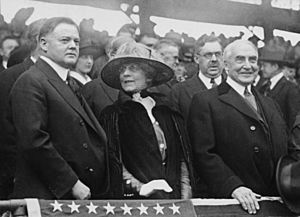
Hoover made the Commerce Department a place for sharing information. He hired many experts to write reports on different parts of the economy. He encouraged standardization of products like car tires to reduce waste. He also worked to reduce accidents in factories and oil spills.
He promoted international trade by opening offices overseas to advise businessmen. Hoover especially wanted to promote Hollywood films around the world. His "Own Your Own Home" campaign encouraged people to buy houses. He worked with banks to create long-term home mortgages. This greatly boosted home construction. He also helped get U.S. Steel to adopt an eight-hour workday. He helped create the Colorado River Compact, which was an agreement about water rights for Southwestern states.
Mississippi Flood Response
The Great Mississippi Flood of 1927 caused huge damage. Millions of acres were flooded, and 1.5 million people lost their homes. Even though disaster response was not part of his job, governors asked President Coolidge to put Hoover in charge. Coolidge agreed and appointed Hoover to lead a special committee.
Hoover set up over one hundred tent cities and a fleet of more than six hundred boats. He also raised $17 million to help. His leadership during this crisis made him very popular. By 1928, many people saw Hoover as even more important than President Coolidge.
The 1928 Presidential Election
Hoover had been quietly building support for a presidential run throughout the 1920s. He was careful not to upset President Coolidge, who might have run again in 1928. But in August 1927, Coolidge announced he would not seek another term. Hoover quickly became the top choice for the Republican nomination.
Many Republican leaders looked for other candidates, but they all declined or failed to get enough support. Hoover won the presidential nomination on the first try at the 1928 Republican National Convention. The convention chose Charles Curtis as his running mate. Hoover accepted the nomination at Stanford Stadium. He promised to continue the policies of the Harding and Coolidge governments. The Democrats chose New York governor Al Smith. Smith was the first Catholic person to be a major party candidate for president.
Hoover's campaign focused on the Republican record of peace and economic success. He also highlighted his own reputation as a successful engineer and public servant. Hoover did not like giving political speeches. He let Curtis and other Republicans do most of the campaigning. Smith was more outgoing than Hoover. But his campaign was hurt by people's dislike of Catholics and his strong opposition to Prohibition. Hoover won the election by a large margin. He got 58 percent of the popular vote and 444 out of 531 electoral votes.
Presidency (1929–1933)
Hoover believed the president could improve life for all Americans by encouraging cooperation between the public and private sectors. He called this "volunteerism." He usually opposed government control or interference. He thought it went against American ideas of individualism. The first major law he signed was the Agricultural Marketing Act of 1929. This law created the Federal Farm Board to help stabilize farm prices.
Hoover used many commissions to study problems and suggest solutions. Many of these groups were funded by private donations. He appointed a Cabinet made up mostly of wealthy, business-minded conservatives. His wife, Lou Henry Hoover, was an active First Lady. She was seen as a modern woman of her time.
The Great Depression Begins
When Hoover took office, he said that poverty would soon be gone from the nation. Many people shared his hopeful view. The stock market was doing very well. However, there were hidden problems in the economy. These included problems for farmers, too many consumer goods, and growing income inequality. The biggest danger was too much speculation in the stock market. This had pushed stock prices far beyond their real value.
In late October 1929, the Stock Market Crash of 1929 happened. The world economy then began to fall into the Great Depression. Hoover believed that a lack of trust in the financial system was the main problem. He wanted to avoid direct government help. He thought the best way to help the economy was to strengthen businesses like banks and railroads. He also worried that giving people "dole" (government handouts) would make the country weaker. Hoover strongly believed that local governments and private charities should help individuals.
Early Responses to the Crisis
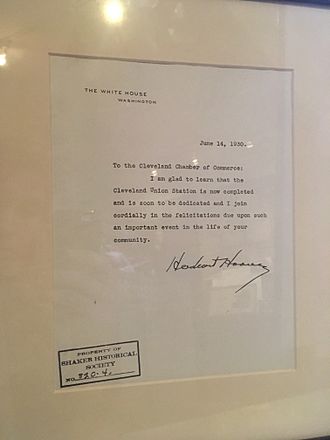
Hoover quickly acted after the stock market crash. He met with business and labor leaders. He asked them not to cut wages or stop work. He thought the economic downturn would be short. Hoover also convinced railroads and public utilities to spend more on building and repairs. The Federal Reserve also cut interest rates. These actions were meant to prevent prices from falling too much and to boost the economy. But Hoover still opposed federal aid for the unemployed. He believed this was the job of states, local governments, and charities.
Hoover had wanted to raise tariffs (taxes on imported goods) to help farmers. But his plan became part of a larger bill that raised tariffs on many goods. Hoover signed the Smoot–Hawley Tariff Act into law in June 1930. Other countries then raised their own tariffs. This led to less international trade and made the economy worse.
Later Policies and Public Opinion
By the end of 1930, the unemployment rate was 11.9 percent. A series of bank failures in late 1930 led to a bigger economic collapse in 1931. Hoover refused to leave the gold standard. He thought other money systems were "collectivism" (too much government control). He believed Europe's weak economy was a big cause of America's problems. He got Congress to agree to stop European war debt payments for one year. This was called the Hoover Moratorium.
By mid-1931, unemployment was 15 percent. People began to realize the country was in a very bad depression. Hoover was a quiet man who disliked public speaking. His opponents in the Democratic Party called him cold, unable to lead, and out of touch. They used insulting names like "Hooverville" for shanty towns where homeless people lived. They also called cardboard used for shoe soles "Hoover leather."
The economy kept getting worse. Unemployment reached almost 23 percent in early 1932. Hoover finally agreed to more direct federal help. In January 1932, he convinced Congress to create the Reconstruction Finance Corporation (RFC). The RFC gave government-backed loans to banks, railroads, and local governments. This saved many businesses. He also signed the Federal Home Loan Bank Act. This created banks to help people get home loans. He also helped pass the Glass–Steagall Act of 1932. This law was meant to increase bank credit. When these actions did not stop the crisis, Hoover signed the Emergency Relief and Construction Act in July 1932. This was a $2 billion public works bill.
Budget and Taxes
After ten years of having extra money, the government had a budget deficit in 1931. Most politicians and economists believed the government needed to keep a balanced budget. In late 1931, Hoover suggested a tax plan to increase government income by 30 percent. This led to the Revenue Act of 1932. This law increased taxes for everyone. The highest earners were taxed at 63 percent of their income. The law also doubled the top estate tax rate and raised corporate tax rates. But even with these new taxes, the government still spent more money than it took in.
Civil Rights and Mexican Repatriation
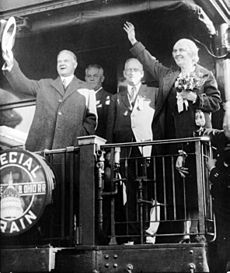
Hoover rarely talked about civil rights as president. He believed that African Americans and other groups could improve themselves through education and hard work. He appointed more African Americans to federal jobs than the previous two presidents combined. However, many African-American leaders criticized Hoover. They were upset that he did not push for a federal anti-lynching law. Hoover also tried to remove African Americans from leadership roles in the Republican Party in the South. This was an effort to gain support from white Southerners. Many African-American voters switched to the Democratic Party in the 1932 election.
To reduce unemployment, Hoover wanted to limit immigration to the United States. In 1930, he made a rule that people needed a job before moving to the U.S. His government also started a campaign to find and remove illegal immigrants. This mostly affected Mexican Americans, especially in Southern California. Many of these removals were done by state and local officials. They were encouraged by the Hoover government. During the 1930s, about one million Mexican Americans were sent to Mexico. About 60 percent of them were U.S. citizens by birth.
Hoover also reorganized the Bureau of Indian Affairs. This was done to limit the unfair treatment of Native Americans.
Prohibition
When Hoover became president, he asked Americans to follow the Eighteenth Amendment. This law had started Prohibition across the U.S. To get ideas for Prohibition policy, he created the Wickersham Commission. Hoover hoped the commission's report would support his view on Prohibition. But the report criticized how the law was being enforced. It also noted that more and more people were against Prohibition.
After the report came out in 1931, Hoover refused to change the law. He worried that doing so would make Prohibition supporters unhappy. But public opinion was turning against Prohibition. More people ignored the law. A movement began to repeal Prohibition. In January 1933, Congress approved a constitutional amendment to end the Eighteenth Amendment. By December 1933, it was ratified and became the Twenty-first Amendment.
Foreign Relations
Hoover was the last American president to take office without needing to focus much on other countries. But during his time, the world order that came after World War I began to break down. As president, Hoover kept his promise not to interfere in Latin America's internal affairs. In 1930, he released the Clark Memorandum. This document rejected the idea of the U.S. interfering in Latin America. Hoover did not completely stop using the military in Latin America. He threatened to intervene in the Dominican Republic three times. He also sent warships to El Salvador to support the government. However, he ended the Banana Wars. He ended the occupation of Nicaragua and almost ended the occupation of Haiti.
Hoover focused on disarmament. He hoped this would allow the U.S. to spend less on the military and more on domestic needs. Hoover and Secretary of State Henry L. Stimson worked to extend the 1922 Washington Naval Treaty. This treaty aimed to prevent a naval arms race. Because of Hoover's efforts, the U.S. and other major naval powers signed the 1930 London Naval Treaty. This was the first time naval powers agreed to limit the size of their smaller ships.
In 1931, Japan invaded Manchuria. They defeated China's army and set up a puppet state called Manchukuo. The Hoover government did not like the invasion. But they also wanted to avoid making Japan angry. They feared that a strong stand would weaken moderate forces in Japan. Hoover and Secretary of State Stimson created the Stimson Doctrine. This said that the U.S. would not recognize lands taken by force.
The Bonus Army
In June 1932, thousands of World War I veterans and their families came to Washington, D.C. They wanted immediate payment of bonuses that had been promised to them for 1945. Congress offered them money to go home, but some stayed. Washington police tried to make them leave. Shots were fired, and two protesters were killed. Many officers were hurt.
Hoover sent U.S. Army forces led by General Douglas MacArthur to the protests. MacArthur believed he was fighting a Communist revolution. He decided to clear out the camp with military force. Even though Hoover had not ordered this, he supported it afterward. This event was very embarrassing for Hoover's government. It hurt his chances of being re-elected.
1932 Re-election Campaign
By mid-1931, few people thought Hoover could win a second term. The economic crisis was too severe. Hoover faced no serious challenge for the Republican nomination in 1932. Franklin D. Roosevelt won the Democratic nomination. The Democrats blamed Hoover for the Great Depression. They said he did not care about the suffering of millions. Roosevelt, as Governor of New York, had helped people in need. This made him seem more willing to use government help during the crisis.
Hoover had planned to give only a few speeches. But he was encouraged by Republicans and angered by Democratic claims. So, he started campaigning more. In his speeches, Hoover defended his government and his ideas about government. He asked voters to stick to what they knew and not believe that government interference could save the country. On his campaign trips, Hoover faced very angry crowds. People threw eggs and rotten fruit at his train and cars. He was often yelled at during his speeches. The Secret Service even stopped attempts to hurt him.
Hoover's efforts to defend his government did not work. Many people blamed him for the depression. In the election, Hoover lost by a lot. He won only 6 states and 39.7 percent of the popular vote. This was a huge drop from his 1928 election results.
Life After the Presidency (1933–1964)
Opposing the New Deal

Hoover left Washington in March 1933. He was upset about losing the election and still being unpopular. From 1933 to 1953, Hoover was the only living former president. He and his wife lived in Palo Alto, California, until she died in 1944. After that, Hoover lived permanently at the Waldorf Astoria hotel in New York City.
During the 1930s, Hoover became more conservative. He closely watched national events. He often criticized Franklin Roosevelt's New Deal policies. Hoover wrote many books, including The Challenge to Liberty (1934). In it, he strongly criticized the New Deal. He called some New Deal programs "fascistic" and "gigantic socialism."
Hoover hoped to be president again throughout the 1930s. At the 1936 Republican National Convention, his speech against the New Deal was well-received. But Alf Landon got the nomination. Hoover gave many speeches for Landon, but Landon lost to Roosevelt. Hoover wanted to oppose Roosevelt at every turn. But other Republicans told him to stay out of the debate over Roosevelt's plan to change the Supreme Court. At the 1940 Republican National Convention, he again hoped for the nomination. But Wendell Willkie was chosen and lost to Roosevelt.
World War II and Later Years
In 1938, Hoover met with Adolf Hitler in Europe. He was worried about the persecution of Jews in Germany. He believed Hitler was crazy but not a threat to the U.S. Instead, Hoover thought Roosevelt was the biggest threat to peace. He believed Roosevelt's policies provoked Japan and discouraged peace with Germany. After Germany invaded Poland in September 1939, Hoover opposed the U.S. joining World War II. He was active in the isolationist America First Committee. He refused Roosevelt's offers to help with relief in Europe. But he did help create the Commission for Polish Relief.
Hoover was not asked to serve after the U.S. entered World War II. This was because of his disagreements with Roosevelt and his continued unpopularity. In 1945, Hoover advised President Harry S. Truman to not demand Japan's unconditional surrender. He worried about the high number of deaths if the U.S. invaded Japan.
After World War II, Hoover became friends with President Harry S. Truman. In 1946, Truman asked Hoover to visit Allied-occupied Germany and Italy. He wanted Hoover to find out what food was needed. Hoover wrote reports that criticized U.S. occupation policy. He said that Germany could not be turned into a "pastoral state" unless 25 million people were moved out. Because of Hoover's idea, a school meals program started in Germany in 1947. It fed 3.5 million children.
In 1947, Truman asked Hoover to lead the Hoover Commission. This group studied how to make the government more organized. Truman accepted some of the commission's ideas to reduce waste and make the White House stronger. Hoover supported the United Nations but did not want the Soviet Union or other Communist countries to join. He saw the Soviet Union as bad as Nazi Germany.
Hoover supported Robert A. Taft at the 1952 Republican National Convention. But Dwight D. Eisenhower won the nomination and the election. Eisenhower appointed Hoover to another presidential commission. But Hoover did not like Eisenhower. He thought Eisenhower failed to undo the New Deal. Hoover's public work helped improve his reputation. He sometimes joked that he was "the only person of distinction who's ever had a depression named after him." In 1958, Congress passed a law giving former presidents a yearly pension. Hoover took the pension even though he did not need the money. In the early 1960s, President John F. Kennedy offered Hoover various jobs. Hoover declined. He defended Kennedy after the Bay of Pigs Invasion and was sad about Kennedy's death in 1963.
Hoover wrote several books in his retirement. One was The Ordeal of Woodrow Wilson. In it, he strongly defended Wilson's actions at the Paris Peace Conference. He also worked on Freedom Betrayed. In this book, Hoover criticized Roosevelt's foreign policy. He especially disliked Roosevelt's decision to recognize the Soviet Union during World War II. The book was published in 2012.
Death
Hoover faced three major illnesses in his last two years. He died on October 20, 1964, in New York City. He was 90 years old. He was the second U.S. president (after John Adams) to reach that age. When asked how he felt about turning 90, Hoover said, "Too old." At the time of his death, Hoover had been out of office for over 31 years. This was the longest retirement for a president until Jimmy Carter broke the record in 2012.
Hoover had a state funeral. He lay in state in the United States Capitol rotunda. President Lyndon Johnson and former presidents Truman and Eisenhower attended. On October 25, he was buried in West Branch, Iowa. His grave is near his presidential library and birthplace. His wife, Lou Henry Hoover, was re-buried next to him.
Legacy and Remembrance
Historical View
Hoover was very unpopular when he left office in 1933. His historical reputation did not start to get better until the 1970s. Historians have praised Hoover for his belief in helping others and for some of his new programs. However, they also note that Hoover was not good at politics. He also did not fully understand how bad the Great Depression was. Some historians say he is remembered as the president who was too conservative to handle the Depression well. He is also seen as the person who helped turn the U.S. from a Republican country into a Democratic one.
Even though his presidency is often seen as a failure, Hoover is praised for his work as a humanitarian. Biographer Glen Jeansonne called Hoover "one of the most extraordinary Americans of modern times." He said Hoover's life was like a "Horatio Alger story," where someone becomes successful through hard work. Historian Richard Pipes said that Hoover "has the rare distinction of having saved millions" of lives through his relief efforts.
Views on Race
Hoover did not use racist remarks or jokes as president. He believed that deliberate discrimination was wrong. He saw himself as a friend to Black people and someone who supported their progress. However, some Black leaders at the time disagreed. W. E. B. Du Bois called him an "undemocratic racist." Some historians believe that Black Americans began to leave the Republican party during Hoover's time. This was partly because he tried to remove Black leaders from the Republican party in the South.
Like many people of his time, Hoover thought white people were naturally better in most areas. He also thought interracial marriages were bad. But he did believe that education and work would help Black people improve. He supported the Tuskegee Institute. His White House broke a social barrier by inviting Jessie De Priest, the wife of a Black congressman, to a traditional tea for congressmen's wives. He also invited the Tuskegee Institute choir to perform.
Memorials and Honors
The Herbert Hoover Presidential Library and Museum is in West Branch, Iowa. It is next to the Herbert Hoover National Historic Site. This library is one of thirteen presidential libraries run by the National Archives and Records Administration. The Hoover–Minthorn House, where Hoover lived as a child, is in Newberg, Oregon. His Rapidan fishing camp in Virginia is now a National Historic Landmark.
The Lou Henry and Herbert Hoover House in Stanford, California, built in 1919, is now the official home of the Stanford University president. The Hoover Institution at Stanford is a research center started by Hoover.
Many things are named after Hoover. These include the Hoover Dam on the Colorado River. Many elementary, middle, and high schools across the U.S. are also named after him. Two small planets, 932 Hooveria and 1363 Herberta, are named in his honor. The capital of Poland, Warsaw, has a square named after Hoover. The historic town of Gwalia, Western Australia has the Hoover House Bed and Breakfast, where he lived. A medicine ball game called Hooverball is also named after him. It was invented to help Hoover stay fit as president.
Images for kids
-
A plaque in Poznań honoring Hoover
Other Honors
Hoover was inducted into the National Mining Hall of Fame in 1988. His wife was inducted in 1990.
He was also inducted into the Australian Prospectors and Miners' Hall of Fame.
Hoover received honorary doctorates from the Charles University in Prague and the University of Helsinki in March 1938.
See also
 In Spanish: Herbert Hoover para niños
In Spanish: Herbert Hoover para niños


